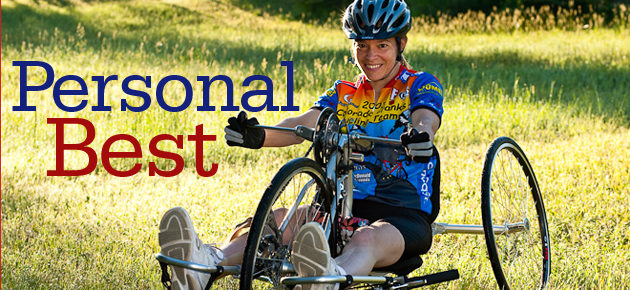
Beth Newsom '95 was in high school when she first noticed something strange. A dedicated runner, the slender brunette regularly brought in prizes for her cross-country team. The state meet during her junior year was no different—her team took first place, and Newsom clocked her fastest time. Afterwards, however, she suddenly experienced a disturbing "pins and needles" numbness in her legs.
"It went away, and I never told anyone about it," she says, but looking back, it was probably the first sign of the illness that took several more years to diagnose.
Newsom, who lives in Parker, Colorado, with her husband and six-year-old daughter, has multiple sclerosis. The disorder, in which the body's immune system attacks the central nervous system, is frightening not only because there is no cure, but also because its progression is unpredictable. Living with multiple sclerosis can mean years of relative health, then a sudden and debilitating "attack" leading to severe loss of function.
For an athlete, it's among the worst of diagnoses—and yet, some twenty years after those first symptoms, and now semi-paralyzed from the waist down, Newsom continues to live as an athlete and to challenge herself as one. She works out with arm weights daily, cycles with a group of disabled athletes who use hand-pedaled cycles, and recently skied for the first time, using adapted equipment that allows her to ski while sitting. A photo of Newsom on the slopes appeared in a February 2009 USA Today article about athletes triumphing over their disabilities.
Newsom credits athletics with helping her overcome the limitations imposed by multiple sclerosis, both physically and psychologically. It all started, she says, with her experience on the track team at Kenyon.
Newsom was at the height of her physical abilities when she arrived at Kenyon as a freshman in 1991. She joined the cross-country team under coach Duane Gomez. It was Gomez who showed her video evidence of the marked wobble that had developed in her stride by her sophomore year, sending her on the road to her diagnosis. "[The video] showed me, O.K., it's real, it's not in my head," Newsom says. She began taking trips to the Ohio State University Medical Center for testing.
There, on February 11, 1993, she heard the official news. That day, she had asked her friend and teammate Kelley Wilder '93 to accompany her. "I had read a lot about MS, but at this point I was doing O.K.," she says. "I was starting to run again." When the doctor said the words "multiple sclerosis," she was stunned. "I remember I said, 'So, should I just lay down on the floor and die?'" Newsom and Wilder walked back to her car, and, she says, "We just sat there and cried."
Back at Kenyon, she rallied, in part by remembering a motivational trick that Gomez had taught her. "Coach Gomez had this method: if you're running a race and you're thinking about the whole 5k, it seems like a long distance," she explains. "But if you break it up into little parts, if you think, 'I can make it to that tree; I can make it to the end of the next block,' it doesn't seem so long. In life, I use that a lot."
Newsom looked down the road ahead: she would no longer be able to run competitively, but she could create other goals. She became the assistant track coach. She switched her major to honors math and economics. She auditioned successfully for the Chamber Singers. During her senior year, she finished the Columbus Marathon.
As her disease progressed and mobility became more difficult, the willpower Newsom learned from long-distance track helped her conquer seemingly impossible challenges. For example, she says, "Somebody told me I couldn't or shouldn't have a baby. Well, I didn't think I could ride a bike again, either. So I went ahead and had a kid." Today, along with raising her child and overseeing the renovation of her house, Newsom is pursuing a master's degree in public administration from the School of Public Affairs at the University of Colorado, Denver. She works as a project coordinator for the healthcare organization Kaiser Permanente, and is a network leader for the Colorado Springs Americans with Disabilities Act Center.
Such a busy existence would be a challenge even without mobility issues, but Newsom works around them. She gets around the house by bracing herself against walls—"or scooting on my butt," she says. For short trips, she uses a walker or leg braces. For bigger distances, she uses a wheelchair, although she resisted it for a long time. "Really, though, it's freed me up. I can go to the mall with it," she says.
Sometimes, Newsom dreams that she's running again. She can still remember how it feels, she says. But the competitions she now wins daily—watching her daughter ski beside her, getting one test closer to her graduate degree—are where the real rewards are found.

 Delicious
Delicious Facebook
Facebook StumbleUpon
StumbleUpon Digg
Digg reddit
reddit